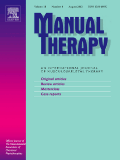
Physical Therapy & Rehab
Active cranio-cervical flexion exercise can improve muscle control for chronic neck pain
This report has been verified
by one or more authors of the
original publication.
Man Ther. 2014 Feb;19(1):25-31. doi: 10.1016/j.math.2013.05.011.
Eighteen adults with chronic idiopathic neck pain were randomized to receive either assisted plus active cranio-cervical flexion (exercise group) or passive mobilisation plus assisted cranio-cervical flexion (mobilisation group). The purpose of the study was to determine which treatment was more efficacious with respect to performance on the cranio-cervical flexion test (CCFT), pain at rest, and pressure pain threshold. Immediately following intervention, both groups demonstrated improvements in pain and pain thresholds, but the exercise group experienced significantly greater improvements. Additionally, electromyographic amplitude of the sternocleidomastoid and anterior scalene muscle activities, measured during the CCFT, were significantly reduced with exercise group exclusively, indicating improved cervical spine muscle control.
Unlock the full article
Get unlimited access to OrthoEvidence with a free trial
Start TrialCritical appraisals of the latest, high-impact randomized controlled trials and systematic reviews in orthopaedics
Access to OrthoEvidence podcast content, including collaborations with the Journal of Bone and Joint Surgery, interviews with internationally recognized surgeons, and roundtable discussions on orthopaedic news and topics
Subscription to The Pulse, a twice-weekly evidence-based newsletter designed to help you make better clinical decisions
Exclusive access to original content articles, including in-house systematic reviews, and articles on health research methods and hot orthopaedic topics
Or continue reading this full article
Register Now

Subscribe to "The Pulse"
Evidence-Based Orthopaedics direct to your inbox.





































